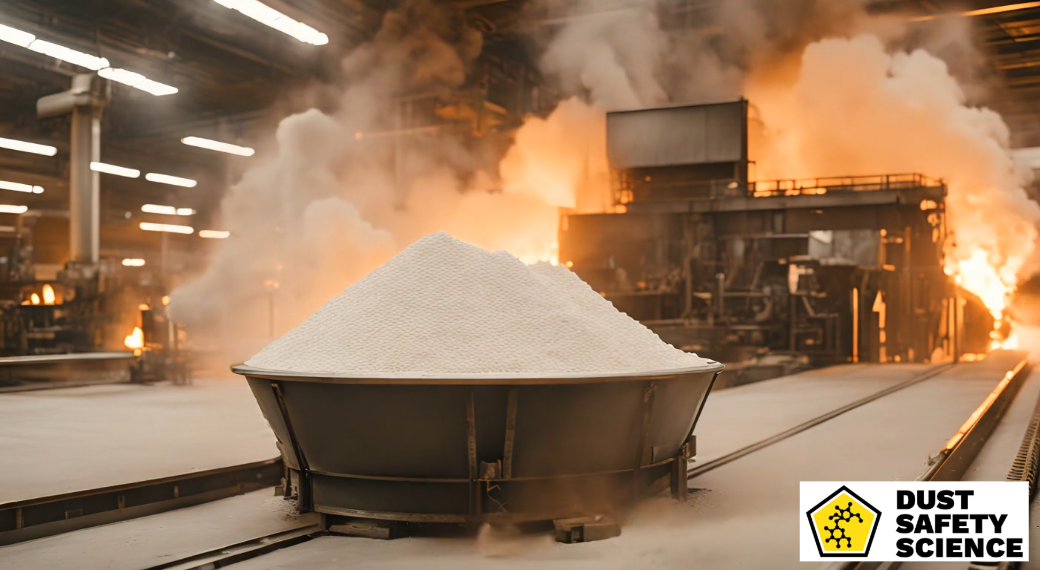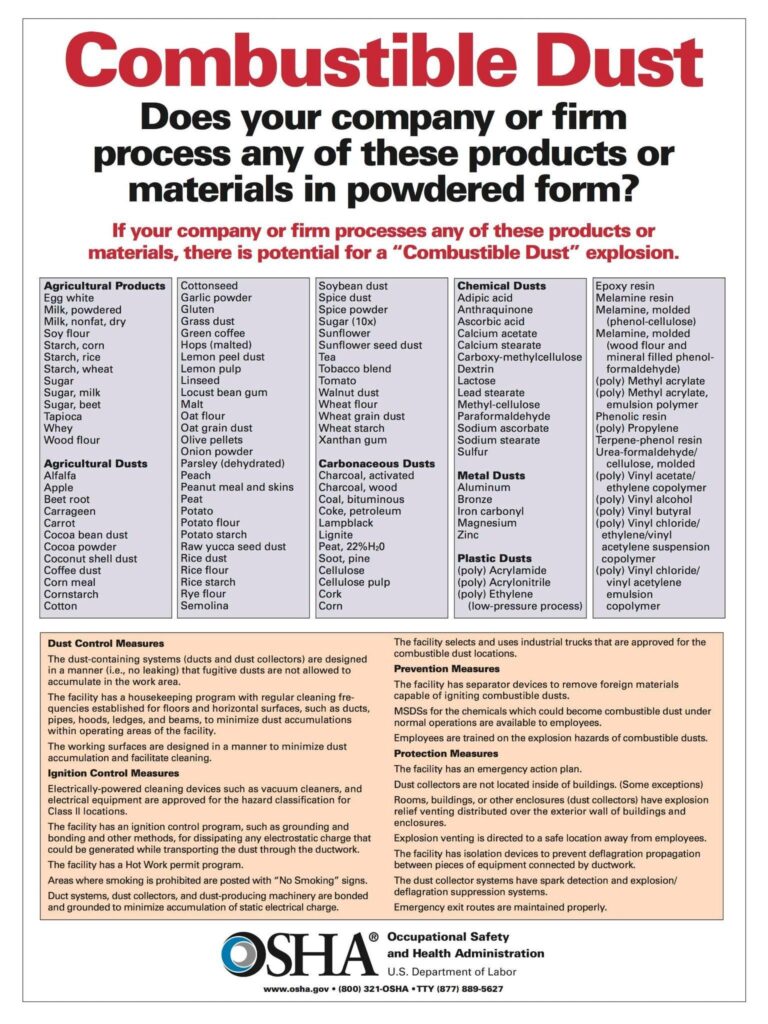Published November 26, 2024 Authors: Dr. Chris Cloney and Jon Barrett of Dust Safety Science

What is Baby Powder?
Baby powder is a dry goods product in many households, commonly used to prevent diaper rash, reduce friction, and keep skin feeling fresh. Despite its widespread use, questions about the safety and flammability of baby powder have arisen, particularly regarding its composition and potential hazards. This article explores the flammability of baby powder, its components, and essential safety practices to ensure safe handling.
Baby powder generally comes in two main types: talc-based and cornstarch-based baby powders.
- Talc-based baby powders: Derived from talc, a mineral composed of magnesium, silicon, and oxygen, these powders are soft and moisture-absorbing. While effective, concerns about contamination with asbestos in some talc sources have been raised over the years. Today, most products labeled as “cosmetic talc” are asbestos free.
- Cornstarch-based baby powders: Made from a carbohydrate derived from corn, these powders are a safer, natural alternative to talc-based options. Cornstarch or Maize, (Zea mays), is more environmentally friendly and does not carry the same health concerns.
Historically, baby powder has been used to prevent irritation in infants, treat oily hair, and provide general comfort. However, modern consumers often seek alternatives due to health and safety concerns, particularly related to talc.
Cornstarch is a common household and industrial product, praised for its versatility and utility. However, despite its widespread use, many are unaware of the risks associated with its flammability.
While its uses are vast, cornstarch poses a significant hazard due to its potential flammability. When suspended in the air, fine cornstarch particles can ignite and cause dust explosions under certain conditions. Understanding these risks is essential for ensuring this material’s safe handling and storage.
Baby Powder is Flammable and is an Explosion Hazard if Cornstarch is an Ingredient
Yes, baby powder is flammable and can be explosive if cornstarch is used as an ingredient. Baby powder is a combustible dust that can create a dust explosion hazard when dispersed into the air in high concentrations. While it is not typically flammable in its solid or bulk form, baby powder becomes highly combustible when dispersed into the air as fine dust. When airborne, the small particles have a large surface area exposed to oxygen, making them capable of igniting if exposed to an ignition source, such as a spark, flame, or static discharge.
However, if talc is the main ingredient in baby powder, there are many possible health issues, including respiratory illness and cancer. Baby powder flammability hazards are present in everyday scenarios and industries:
- Ignition sources: Baby powder as cornstarch can burn or explode if there’s an ignition source, such as an open flame, spark, hot surface, electrical equipment, smoking, or static electricity.
- Real-world examples: Cornstarch has been used in events like color runs, and Holi festivals celebrated worldwide, Holi Powder and Coloured Powders such as cornstarch and dyes, are thrown into the air, causing a dust cloud and combustible dust explosion hazard, in crowds of people, with candles, flames, and lighters. which can create a fire hazard if the particles are the right size and concentration. According to CNN, in 2015, a fire at a Taiwanese water park “Color Play Asia” event, was likely caused by colored cornstarch thrown over a crowd, creating hazardous dust clouds..
- Hair Salons and Barber Shops: Baby powder is commonly used in barber shops and hair salons to absorb moisture, prevent irritation, and provide a polished finish after haircuts. However, its use in these environments can pose dust hazards. The fine particles in baby powder, talc, or cornstarch-based products, can become airborne during application, creating a potential respiratory risk for workers and clients.
Prolonged inhalation of these particles may cause lung irritation and, in some cases, contribute to respiratory conditions. Additionally, the powder’s airborne dispersal in enclosed salon spaces increases the risk of fire if exposed to heat sources, electrical equipment, or open flames like candles or hair drying tools. To minimize risks, salons are encouraged to use powder sparingly, opt for safer alternatives, and ensure proper safety precautions.
Key Points About Baby Powder Flammability:
- Dust Clouds: Baby powder as cornstarch forms combustible dust clouds that can ignite and lead to explosions if the right air-to-fuel ratio exists. An example is throwing bulk organic material into the air, which forms a dust cloud.
- Ignition Temperature: The temperature required to ignite cornstarch dust in baby powder is relatively low, making it a potential hazard in industrial and processing environments.
- Static Electricity: Baby powder as cornstarch can burn or explode with an ignition source, such as an open flame, spark, hot surface, electrical equipment, smoking, or static electricity.
- Confined Spaces: Dust explosions are more dangerous when baby powder as cornstarch dust, accumulates in confined spaces, as the pressure can lead to secondary explosions.
Baby Powder as a Combustible Dust
Baby powder as cornstarch is considered combustible dust, and other combustible materials and products, such as paper, wood, metal, coal, plastic, cotton, and rubber that may combust in powdered form are extensive and include a wide range of materials. Some materials, such as Zinc or Potatoes are not combustible in larger bulk material pieces but can be when pulverized to fine dust. Coal is both combustible as a bulk material and as coal dust. The US Occupational Safety and Health Administration (OSHA) maintains a comprehensive list of combustible materials.
Combustible dust refers to finely divided solid particles that are prone to ignition and ignition sources when suspended in the air. These particles can originate from various materials and industries, including agriculture, manufacturing, and chemical processing. Combustible dust can pose severe risks, including dust explosions and fires. A combustible dust cloud consists of fine particles suspended in the air, exposed to an ignition source, which leads to a fire or explosion. Combustible dust is created from various materials, including organic substances like wood, grain, metals, plastics, and chemicals. For dust to become a significant hazard, the particles must be the right size, and there must be enough oxygen and a confined space or enclosed area. Dust clouds form when fine particulate matter becomes airborne, often due to industrial activities such as cutting, grinding, or transporting materials. These clouds can form in hidden areas such as rafters, ductwork, or equipment, leading to dust explosions.
The Occupational Safety and Health Administration (OSHA) in the United States defines combustible dust as “a solid material composed of distinct particles or pieces, regardless of size, shape, or chemical composition, which presents a fire or deflagration hazard when suspended in air or some other oxidizing medium over a range of concentrations. Understanding these characteristics is vital for identifying dust hazards, managing the risks associated with explosive dust, ensuring workplace occupational safety and compliance, and preventing a combustible dust explosion.
The NFPA 654 Standard for the Prevention of Fire and Dust Explosions from the Manufacturing, Processing, and Handling of Combustible Particulate Solids, provides guidance on combustible dust suppression and dust control. The NFPA 654 Standard is referenced by OSHA’s Combustible Dust National Emphasis Program (NEP) to identify dust hazards and define mitigation strategies that help protect life and property. The standard provides industry-recognized safety practices for flour mills, facility and systems design, process equipment protection, fugitive dust control and housekeeping, ignition source identification and control, fire protection, training and procedures, inspection, and maintenance. The NFPA also specifies using explosion proof equipment and anti static tools and equipment and materials for handling dust, from static electricity issues.
Safe Handling and Storage of Baby Powder
To minimize fire risks, follow these precautions:
- Storage: Keep in a safe dry area, or a container, and ensure both are explosion proof and anti static.
- Dust Control: Use appropriate dust collection systems to prevent accumulation.
- Ventilation: Ensure proper airflow to dilute dust concentrations.
- Ignition Control: Eliminate open flames, sparks, cigarettes, light fixtures, electrical outlets, motors, engines, and static buildup.
- Avoid aerosolization: Do not shake or disperse baby powder near open flames or heat sources. Sprinkle it gently to reduce airborne particles.
- Proper storage: Store baby powder in a cool, dry place, away from direct sunlight, heaters, or cooking areas.
- Keep out of reach of children: This prevents accidental inhalation or misuse.
- For added safety, always read and follow the manufacturer’s instructions on the product label
Safety Guidelines, Compliance, and Best Practices, to Prevent Baby Powder Dust Explosions
Organizations like OSHA and NFPA have established guidelines, including:
- NFPA 654: Standards for the prevention of fire and dust explosions.
- OSHA’s Combustible Dust NEP: Emphasizes inspections and hazard communication.
Emergency Response Strategies to Baby Powder incidents include:
- Training: Equip employees with knowledge of safe handling and use of Baby Powder, and emergency protocols.
- Suppression Systems: Install automatic fire suppression and explosion venting systems.
Facilities and people handling baby powder with cornstarch must conduct regular dust hazard analyses, and implement explosion prevention measures. The consequences of Non-Compliance and failure to comply can lead to fines, facility closures, and liability for damages resulting from accidents.

Technology Advances, with the Integration of Artificial Intelligence, (AI), Machine Learning, (ML), and the Internet of Things, (IoT), in Managing Baby Powder Dust Explosions
Technological advancements, particularly the integration of Artificial Intelligence (AI), Machine Learning (ML), and the Internet of Things (IoT), are transforming how industries manage dust explosion risks, including those from baby powder. AI-powered systems analyze vast amounts of data to predict potential explosion hazards by identifying critical environmental factors such as particle concentration, temperature, and airflow. Machine Learning algorithms enhance this capability by learning from historical incidents and adapting to new patterns, enabling more precise risk assessment. These intelligent systems act as an early warning mechanism, providing actionable insights that empower operators to mitigate risks proactively.
IoT further enhances these technologies by connecting devices and sensors in a seamless network, allowing for real-time monitoring and rapid response. For example, IoT-enabled sensors can continuously measure dust density in the air and communicate directly with control systems to adjust ventilation or shut down equipment in hazardous conditions. This interconnected ecosystem not only reduces the likelihood of human error but also ensures compliance with safety regulations. Together, AI, ML, and IoT create a smarter, more responsive framework for managing combustible dust risks, safeguarding both workers and facilities.
Conclusion
Understanding the composition and potential risks of baby powder is essential for safe usage. While not highly flammable under normal circumstances, both talc- and cornstarch-based powders can pose fire risks when dispersed or sifted as fine dust and create a dust cloud. By following safe handling practices and exploring alternative products, you can minimize hazards while reaping the benefits of baby powder.
Awareness and proper storage are key to preventing accidents. Whether using talc-based, cornstarch-based, or alternative powders, prioritize safety to protect yourself and your family.
About Dust Safety Science
Dr. Chris Cloney, of Dust Safety Science, provides additional information on Starch dust explosions, with a Podcast. Click on the latest Podcast Link: Incident Update – 2021 Potato Starch Explosion in Tuas, Singapore

Resources:
Visit: Fire and Explosion Protection Equipment Providers
Visit: Risk Assessment & Dust Hazard Analysis Providers
Visit: Combustible Dust Testing Providers
Visit Dust Safety Science (Global Incident Tracking)
Visit Dust Safety Academy (Resources, Training, and Events)
Visit Dust Safety Professionals (Need Help? Get Support Today!)
VisitDust Safety Journal for the Dust Safety Science Monthly Journal
Subscribe to our Dust Safety Science Newsletter at Dust Safety Science Newsletter
Visit the Dust Safety Science blog for written articles on combustible dust safety including the latest research, expert opinions, and state-of-the art fire and explosion protection.
